What Is CMOS, Complementary Metal Oxide Semiconductor, Diagram
Hello guys, welcome back to my blog. In this article, I will discuss what is CMOS, applications of CMOS, characteristics of the complementary metal-oxide semiconductor, etc. Each and everything I will try to explain in a simple way.
If you have any doubts related to electrical, electronics, and computer science, then ask questions. You can also catch me on Instagram – Chetan Shidling.
Also, read:
- Roadmap To Becoming A VLSI Engineer Or Chips Design Engineer.
- Top 09 EDA Tools For VLSI Chip Design.
- What is VLSI, Very Large Scale Integrated Circuit, Design Flow
CMOS
What is CMOS?
The complete form of CMOS is a Complementary Metal Oxide Semiconductor. C-MOS is a major class of integrated circuits. CMOS chips include a microprocessor, microcontrollers, memories like RAM, and other digital logic circuits. The term “complementary” relates to the point that design uses symmetrical pairs of p-type and n-type MOSFET transistors for logic functions, only one of which is switched on at any time.

The CMOS is a combination of PMOS and NMOS as shown in the above figure. The PMOS is responsible for charging whereas the NMOS is responsible for discharging. The PMOS has the advantage of charging and has a disadvantage while discharging, whereas the NMOS has the advantage of discharging and has the disadvantage of charging because of power loss.
By taking advantage of PMOS and NMOS, the C-MOS is built. Now let’s see the working of CMOS.

We all know that the PMOS will be turn on only when we give low input to the gate and the NMOS will be turn on only when we give high input to the gate. Now we will see what happens if we give high and low input to the CMOS.

When we give high input, the gate of PMOS is high, thus the PMOS will be turned off and NMOS will turn on, thus the output(Y) will be connected to the ground and the output will be low.

When we give low input, the PMOS transistor will turn on and the NMOS transistor will turn off, then the output will be connected to the Vdd means the output will be high. The output is high when input is low.
DC Characteristics Of C-MOS


As we can see in the above figure that the output is high when the input is low and output is low when the input is high.
Applications Of C-MOS
01. Micro-processor
02. Micro-controller
03. Amplifiers
04. Logic circuits
The integrated circuit means many transistors are used to build a chip. The complementary metal-oxide-semiconductor has some advantages such as low cost, fast operation, low power consumption, etc.
It is a popular metal oxide semiconductor (MOS) logic. CMOS family combines both P and N channel devices in the same circuit to obtain advantages of PMOS and NMOS families.
Characteristics Of CMOS family
01. Propagation delay (25 ns to 100 ns it is greater than TTL).
02. Power dissipation 0.1 MW at 100 kHz and 1 MW at 1 MHz.
03. Speed power product = 0.7 Pj.
04. Fanout 50.
05. Basic gate used NOR or NAND.
06. Fain in 10.
07. Noise margin 1.5 volts.
Advantages Of CMOS Or Complementary Metal Oxide Semiconductor
01. CMOS consumes less power as compared to TTL.
02. CMOS has a higher margin for noisy signals that is a better noise margin.
03. Fan out is more.
04. Wide supply voltage range so greater design flexibility.
05. CMOS_technology has been used to construct small, medium, and large scales integrated circuits.
06. Because of small power consumption it is useful for application in watches and calculators.
07. Greater packing density so permits more circuitry in a given area.
Disadvantages Of CMOS Logic Family
01. It is slower than TTL.
02. Sensitive to electrostatic charges. Hence precautions to be taken while handling these devices.
03. Switching speed is less.
I hope this article may help you all a lot. Thank you for reading. If you have any doubts related to this article, then you can ask questions for us – Ask Question.
Also, read:
- Difference Between Domain And Zonal Architecture in Automotive: A Complete Guide
- Roadmap To Become A Successful Hardware-in-the-Loop (HiL) Engineer
- 1000+ Automotive Interview Questions With Answers
- RTOS In The Automotive Industry: The Brains Behind Real-Time Vehicle Control
- High Performance Computers in Software-Defined Vehicles (SDVs): Architecture, Challenges, and Future Trends
- Automotive HPC Wars: The Race To Power Software-Defined Vehicles
- Why The Automotive Industry Is Down: No Automotive Jobs and When Will It Become Normal Again?
- Lane Departure Warning Systems: Your Guardian on the Road
- In-Depth Guide To UDS Service 0x19 – ReadDTCInformation
- Testing Techniques For Test Case Writing in the Automotive Domain

